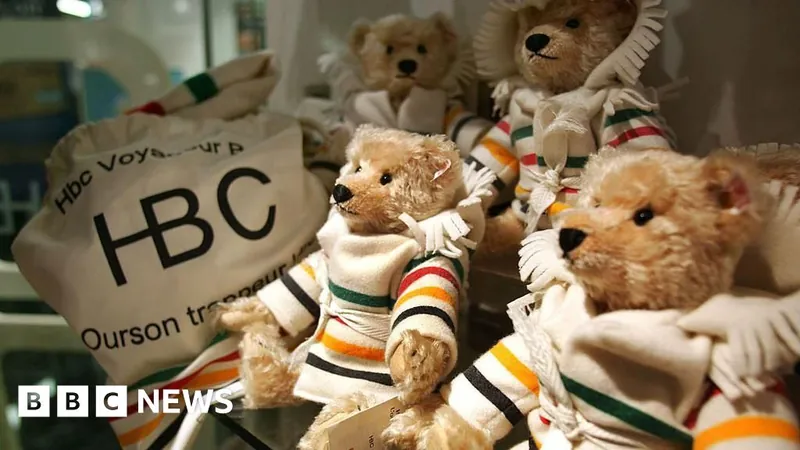
The Hudson's Bay 'Stripes' Craze: Why Shoppers Can't Get Enough of This Iconic Merchandise
2025-04-06
Author: Ying
The Hudson's Bay 'Stripes' Craze
As the sun sets on a bustling weekday in Toronto, the shopping atmosphere is electrifying. Shauna Daniels, an enthusiastic shopper, has taken to the streets on a mission to find “stripes” – a term that has taken on new meaning for many Canadians recently. These vibrant, multicolored stripes are iconic products from the Hudson's Bay Company (HBC), Canada’s oldest retail institution, and their popularity is skyrocketing.
Following HBC's shocking announcement to liquidate nearly all of its department stores across Canada, a fervent wave of demand for its stripe-patterned merchandise has emerged. Handcrafted wool blankets and patio umbrellas, which once fetched around C$300, are now being resold on platforms like eBay for upwards of C$1,000 (approximately $710 or £540). This phenomenon has left many bewildered but eager to collect a piece of Canadian history.
The emotional connection that shoppers like Daniels feel toward HBC's stripes is palpable. For many, these products symbolize nostalgia and a significant chapter in Canadian history. Daniels reminisces about her childhood memories of skating in downtown Toronto and admiring the department store windows, a stark reminder of days gone by.
This surge in interest for HBC products coincides with a growing movement among Canadians to prioritize local spending, particularly in light of increasing tariffs from the United States. As more Canadians rally behind the “buy Canadian” initiative, HBC has seen a remarkable boost in sales, helping the company pay down some of its almost one billion dollars in debt while managing to keep six locations from closing their doors completely.
Despite these efforts, HBC has still seen 80 stores shutter, along with several Saks Fifth Avenue locations in Canada. This wave of liquidation marks a bittersweet moment for a brand ingrained in the Canadian identity since its inception in 1670. Initially, HBC was granted a royal charter to oversee trade in what is now Canada, trading woolen “point” blankets with Indigenous communities. The distinctive stripes of these blankets were not just a fashion statement; they are deeply rooted in Canada's colonial past.
With each passing decade, Hudson's Bay shifted its focus from fur trading to retail, opening its first store in Winnipeg in 1881. The company embraced its storied history by popularizing the striped blankets for mass retail in 1929, which subsequently adorned all manner of home décor items. Interior designer Kate Thornley-Hall has even repurposed these blankets into unique designs like pillow cushions and ottomans, showcasing the enduring appeal of HBC's stripes in contemporary design.
Over the years, Hudson's Bay has transformed its storefronts into essential destinations for shoppers and tourists alike, thanks to their ornate stone facades. However, after a private equity firm acquired the brand in 2008, a shift towards American ownership began to change the landscape. Like many retail giants, HBC struggled to adapt to the rise of online shopping, and the COVID-19 pandemic only intensified these challenges, pushing consumers towards platforms like Amazon, Walmart, and local discount stores.
Retail analyst Bruce Winder notes that while an outright return of department stores may be unlikely, there is a possibility for a second chance for HBC. Some shoppers are optimistic that the renewed interest in the iconic stripes could revive the brand and encourage Canadians to support luxury local shopping instead of fast fashion.
As the future remains uncertain for Hudson's Bay, experts suggest avenues like licensing its famous stripes to other companies or transforming into smaller, HBC-branded boutiques. There is still a foundation of affection for the brand, albeit potentially centered on select heritage items.
In a world rapidly changing towards e-commerce, the nostalgia and pride resonating with Hudson's Bay's stripes may just hold the key to its revival, inviting shoppers to rediscover the importance of supporting Canadian history and craftsmanship. With this resurgence, could we be witnessing the rebirth of a legendary retailer? Only time will tell.



 Brasil (PT)
Brasil (PT)
 Canada (EN)
Canada (EN)
 Chile (ES)
Chile (ES)
 Česko (CS)
Česko (CS)
 대한민국 (KO)
대한민국 (KO)
 España (ES)
España (ES)
 France (FR)
France (FR)
 Hong Kong (EN)
Hong Kong (EN)
 Italia (IT)
Italia (IT)
 日本 (JA)
日本 (JA)
 Magyarország (HU)
Magyarország (HU)
 Norge (NO)
Norge (NO)
 Polska (PL)
Polska (PL)
 Schweiz (DE)
Schweiz (DE)
 Singapore (EN)
Singapore (EN)
 Sverige (SV)
Sverige (SV)
 Suomi (FI)
Suomi (FI)
 Türkiye (TR)
Türkiye (TR)
 الإمارات العربية المتحدة (AR)
الإمارات العربية المتحدة (AR)